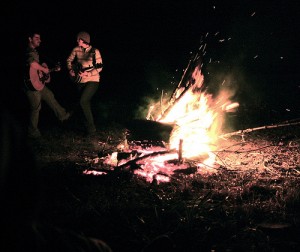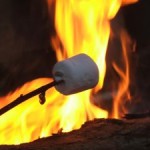What better way to end a perfect day of camping than with a bright, cheerful (or scary!) campfire? Wonderful memories of campfire activities will last a lifetime. Family and friends come together at the end of the day to wind down and relax. The first step is building the best campfire ever, which will be the focal point of the gathering.
Types of Campfires
- The Pyramid-start with a bottom layer of logs that are 4”-6” in diameter placed in a square shape. Add additional layers of smaller, shorter logs until you reach the desired height. Fill the space in the middle with kindling and tinder. Light the fire on a small platform of twigs near the top so that the burning cinders fall into the middle of the pyramid.
- A Log-Cabin style fire starts with 2 large logs as the base running parallel. Place the next level of smaller logs perpendicular to the base. Continue alternating for a few layers. Fill the space between with kindling. This is important so that the fire does not burn too fast.
- A Tepee fire is made by stacking wood on its end so that the tops meet and form a shape like a tepee. Kindling and tinder should be placed in the middle, and the fire is lit from the bottom.
How big you build your fire depends on many things; the most important of which is your surroundings. Do you have a designated fire pit, or area that is safe to build a larger fire in? Make sure you have permission before building any fires and take into consideration the age of the participants. If you have several young children a roaring bonfire is an accident waiting to happen. Explain campfire rules and safety tips before the excitement begins.
Songs to Sing Around Campfires

Campfire Songs, Photo by miamabanta @ Flickr
There are hundreds of songs that may be sung around a campfire. Don’t be afraid to ask for suggestions, or let campers make up new songs.
Storytelling is another great activity to engage in around a campfire. Appropriate stories for younger children may be told earlier. When they are sent off to bed, older children and adults may tell stories that are a bit scarier. If younger children are really frightened-stop the story.
A Scary Story for Younger Children
This is a classic story that most children learn early. Choose a youngster’s name from the group, or a generic name.
Once there was a (girl/boy) named (say name).
One night (she/he) woke up about midnight because (she/he) heard someone walking downstairs.
Step…step….step
(She/He) quickly pulled the covers up over (her/his) head and shivered.
Then (she/he) hears a wavery voice: (say the next line slowly in a scary voice)
“ (Say child’s name) I’m on the first step and I’m coming to get you!”
Then, (Say child’s name) heard another step and then the voice said
” (Say child’s name) I am on the second step and I am coming to get you!”
Well every step the voice called to (her/him) until the voice was right beside (her/his) bed.
“(Say child’s name) I am right beside your bed!”
(crouch down in front of the audience)
“(Say child’s name)! (pause)
I GOTCHYA! Jump at the campers as you yell
Stories for Older Children
Most pre-teens and teenagers know at least one version of the old classic about the couple that go on a date and meet the escaped maniac with the hook. If you prepare ahead of time with a Halloween prop this is a real scream. Local ghost stories are also great.
Another classic campfire story that needs proper staging is “The Cremation of Sam Mcgee”, by Robert Service. This story works best is the presenter can memorize it first. The campfire should either be built up so that it is blazing, or if the coals are dying down, the storyteller may hold a flashlight in front of their face for effect.
by Sandra M. Webster



